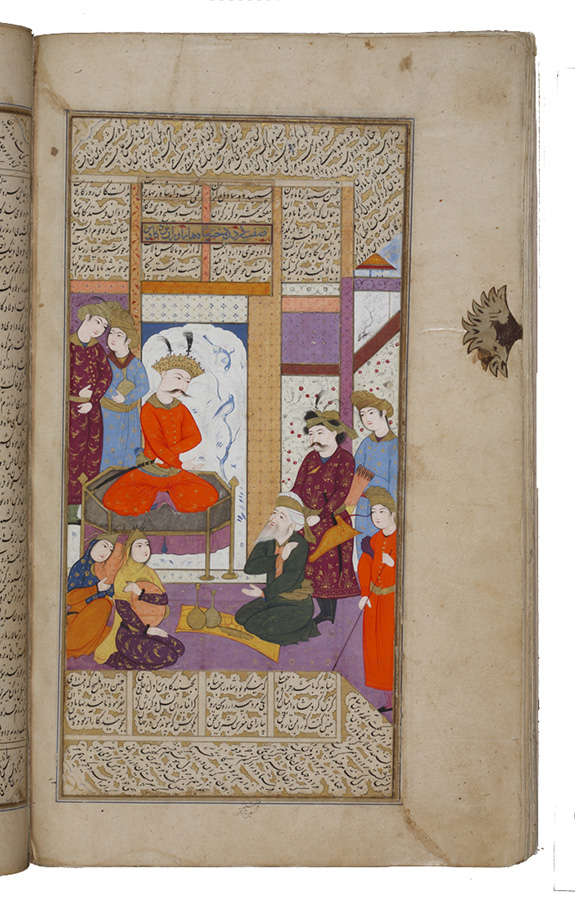Manuscript B, no. 2-087 (David folio 102b)
The Envoy of Kay Kāvos Asks for Sudāba 's Hand from Her Father, the King of Hāmāvarān
Location: The David Collection, Copenhagen, Denmark, #217/2006, folio 102b.
Page: 35.2 x 21.8 cm.
Painting: 21.6 x 15.3 cm. (Scaled) including extension into left margin
Text area: 28.7 x 14.0 cm. (Scaled)
Signature in the center of the lower margin: raqam-e kamina moʿin-e moṣavver.
The page with this illustration is out of order and originally should have appeared in the chapter on the reign of Kay Kāvos. The story takes place early in the reign of Kay Kāvos, following a battle with the King of Hāmāvarān in which the Iranians were victorious. Having sued for peace, the King of Hāmāvarān gave generous tribute to Kay Kāvos. The Shah then learned that the King of Hāmāvarān had a beautiful daughter and sent his envoy to request her hand in marriage. Although the King bemoaned the loss of his only daughter, Sudāba herself stated her wish to marry Kay Kāvos, and her father agreed to the union.
The one other illustration of this episode listed but not illustrated in the Cambridge Shahnama Project dates to the second half of the 17th century and is described as Kay Kāvos asking to marry the daughter of the King of Hāmāvarān. It is not explicit about whether the painting depicts the Iranian envoy at the court of Hamavaran or if it shows either the envoy with Kay Kāvos or the person telling Kay Kāvos about Sudāba before the envoy leaves on his mission. The same problem exists here. The king is seated on a backless throne while an elderly, bearded man dressed in a green robe kneels before him. Graybeards in this role are often considered sages in Persian painting, a status that the robe of green, the color of Islam, may support. Behind him stands an official who carries a bow and arrows, while pairs of young female musicians and male servants are arrayed at the edges of the scene. The two birds in the mural behind the king "converse", perhaps an echo of the discourse taking place between the king and the kneeling man.
Painting references:
Canby_ Journal_2010, pp.66-67 no. 15 and p.93, fig.25.
Text references:
Warner, II, pp.86-88.
Photo: Permille Klemp. Courtesy of The David Collection, Copenhagen
Sheila R. Canby
Last Updated: April 6, 2014 | Originally published: 2010
